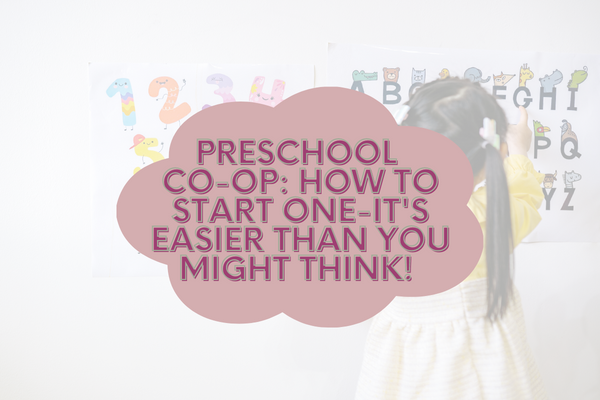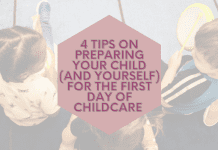 Have you ever felt like you don’t want to miss a single second of your child’s life, but also like, whoa, mama needs a minute alone? Enter Preschool Co-ops!
Have you ever felt like you don’t want to miss a single second of your child’s life, but also like, whoa, mama needs a minute alone? Enter Preschool Co-ops!
As a mom of four, I always want to be involved in what I can…but as a mom of four, I have four kids!
That’s a lot of stretching and coordinating and balancing.
When my oldest turned preschool age, I wasn’t ready to let her go, but I knew it was time for her to stretch her wings.
I wanted a preschool option that would help her become socially acclimated and learn necessary preschool skills, like sitting for longer periods of time, school etiquette, waiting, taking turns, etc. Most importantly, I wanted her to gain confidence when it was time to go to a much larger school.
I learned about a preschool co-op program called, Joy School, through some of my in-laws and it sounded like it was going to be a perfect fit! While I chose Joy School for our curriculum, all of these tips and tricks can help you set up a co-op of your choice.
XO,
Karlee Soelberg, a Gilbert mom
So, what is a preschool co-op?
A group of parents that create or use an already established curriculum to teach a preschool-like class for a small group of children, usually in their own home. Parents take turns being the teacher and hosting the group.
Why choose this over a traditional preschool?
While a traditional preschool is a more hands-off approach, a co-op gives you an up close and personal look into your child’s beginning education and you (the parent) get a turn to be the teacher! It is so fun!
You get to help create the curriculum or pick and choose what to include in an already established curriculum.
It is a great way to bond with your child in a relaxed, educational setting and see first hand which areas they excel in and which areas they may need more help in. It’s also a great way to balance that desire to be involved and still let your child be independent in different settings.
PRO TIP: There is no guilt in doing either a traditional or co-op style! Find what truly fits your family’s needs and go with that!
How much does it cost?
This is one of the best parts! Traditional preschools can range from $200-$1,000 or more per month in Arizona (according to google).
Wih a co-op, you just pay for a curriculum, or make your own for free.
The only other costs are for supplies that get shared and passed from house to house each week and each host is expected to provide a snack for the group on their teaching days.
The Joy School Program is a one time fee of $179 for a lifetime membership! There are no extra fees or yearly contributions required. This is pretty unique and an awesome perk!
I have been able to use the curriculum I purchased six years ago, with three of my four children so far.
We have literally saved thousands of dollars with our three kids using this program! Joy School does ask that each involved family purchase their own curriculum.
How do you set up a successful co-op?
First, you have to find the right curriculum for you. A quick google search will pull up dozens of programs and available curriculums around the Valley or online. You can also create your own curriculum, if that’s more your jam.
In my case, I chose Joy School. The curriculum is ready to use through an online portal that you can easily access and print off materials or view the lesson plans. You pay a one time fee for a lifetime membership!
Once everyone has the curriculum, parents should gather and discuss a rotating teaching schedule. Typically, each parent takes two days in one week for their teaching slot. It can be as flexible or rigid as the group wants it to be.
You take your teaching week and pass a box of supplies (crayons, glue sticks, calendar, weather chart, etc) to the next parent the following week.
So, if you have five kids in the group, you are only teaching two days a week, every five weeks.
This type of scheduling will allow the parent the freedom to accomplish other tasks while their child is gone but still lets them be super involved when their teaching week rolls around again.
PRO TIP: Communicate with the other parents to troubleshoot problems, set up a reward system, and enjoy all the cute things the kids say!
How do you find other families to participate?
Start by asking the Moms in your neighborhood and then reach out to family and friends who live nearby.
Once you get enough interested parents, you set a time to meet and go over scheduling and curriculum.
Each Mom (or Dad or guardian) picks the weeks that they can teach the class in their home and you set up a rotating schedule from there.
PRO TIP: Have a playdate with all the kids to get a feel for how they get along. It makes it really easy if you live close to the other families and it helps create lasting friendships!
PRO TIP: Follow the local school district calendar for families that have older kids in school. By doing this, all of the holiday breaks will line up nicely.
What is the best age to include?
I have had the most success with ages 3-4 and 4-5!
They are old enough to listen to directions and sit for more than a couple of minutes at a time. It is really fun when the kids want to do the activities and are old enough that they can focus on the task at hand.
Ages 3-4 works well if you plan to do two years before kindergarten. The younger you go, the more you have to adjust your expectations for a successful class. If you are working with age 3 or under, I would include more movement breaks, more songs and dances, and definitely more snacks!
PRO TIP: Limit the class to 4-6 kids, depending on the ages. It gets a little tricky to manage 6 three year olds, especially if you have other kids at home too. Take that into consideration when you are finding families who want to join your co-op!
PRO TIP: Take notes and pictures of the funny things the kids say or do during class and share with the parents!
Why did I choose the Joy School curriculum?
The Joy School curriculum has been around since 1980, and fair warning, its style has stayed in the 80’s as far as dated clip art and old fashioned children’s songs. However, I loved the emphasis on joy and emotions, rather than strictly academics.
With Joy School, the children work through units such as the Joy of the Earth, the Joy of Honesty and Communication, The Joy of Imagination and Creativity, and one of my personal favorites, The Joy of Uniqueness, which emphasizes how special each individual child is and celebrates their differences.
I have found that focusing on more emotional needs at this age helps prepare them to enter a new, bigger, learning environment as kindergarten approaches.
Every child in kindergarten will of course get the basics, ABC’s and numbers 1-10, but not every child will get the emotional boost that can be so helpful to spark confidence and a joy for learning!
Another reason this was the winner for our family, as mentioned above, is because of the cost! A traditional preschool setting in Arizona can cost anywhere from $200-$1,00 or more per month (according to google)! Joy School tuition is a one time cost of $179 for a lifetime membership that you can use over and over again with all of your children.
There are so many great options out there to fit any circumstances so if you choose to do a co-op preschool, don’t stress! It can be so much fun with a little planning and a lot of flexible expectations!










